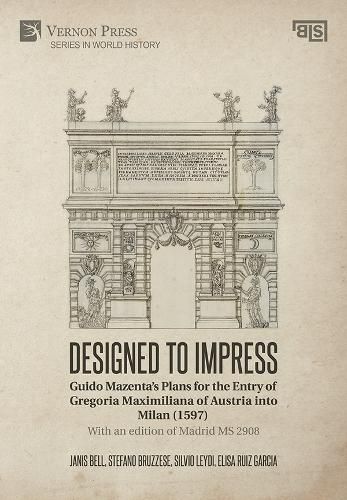Readings Newsletter
Become a Readings Member to make your shopping experience even easier.
Sign in or sign up for free!
You’re not far away from qualifying for FREE standard shipping within Australia
You’ve qualified for FREE standard shipping within Australia
The cart is loading…






This title is printed to order. This book may have been self-published. If so, we cannot guarantee the quality of the content. In the main most books will have gone through the editing process however some may not. We therefore suggest that you be aware of this before ordering this book. If in doubt check either the author or publisher’s details as we are unable to accept any returns unless they are faulty. Please contact us if you have any questions.
Soon after celebrating the appointment of Federico Borromeo to Archbishop, the city of Milan began planning elaborate festivities to celebrate the betrothal of Prince Philip, future King of Spain, to the niece of the Holy Roman Emperor, Gregoria Maximiliana. She was scheduled to travel through Milan in 1597 on her journey to Spain. Guido Mazenta, a private citizen, planned for the erection of five triumphal arches in strategic locations throughout the city. This volume includes studies of the author and his previously unrecognized importance in turn-of-the-century Milan, presents an analysis and transcription of his illustrated manuscript for the program (Biblioteca Nacional Ms. 2908), and fully examines the scope and expenses of the festivities in honor of royal visitors in the second half of the sixteenth century. Although Gregoria died before the planned celebration, many of its features were transferred to the entry in 1598 of her sister, Margherita, who married Philip soon after he ascended to the throne as Philip III of Spain. This celebration left a permanent mark on the city of Milan through the construction of the Porta Romana.
Scholars of early modern European art and history will find a richness of new archival documentation, particularly those interested in the history of book and art collecting and in economic history. The essays in this volume bring to light the important role of a private citizen whose reputation was later deliberately obscured to cover the ignominy that led to his exile from Milan. Janis Bell and Stefano Bruzzese discuss the author and his activities, Silvio Leydi discusses the many elaborate festivities conducted for royal visitors to the city of Milan during the Hapsburg reign and the expenses involved in hosting their courts, and Elisa Ruiz Garcia presents a detailed examination of the program and the sources used by the author.
$9.00 standard shipping within Australia
FREE standard shipping within Australia for orders over $100.00
Express & International shipping calculated at checkout
This title is printed to order. This book may have been self-published. If so, we cannot guarantee the quality of the content. In the main most books will have gone through the editing process however some may not. We therefore suggest that you be aware of this before ordering this book. If in doubt check either the author or publisher’s details as we are unable to accept any returns unless they are faulty. Please contact us if you have any questions.
Soon after celebrating the appointment of Federico Borromeo to Archbishop, the city of Milan began planning elaborate festivities to celebrate the betrothal of Prince Philip, future King of Spain, to the niece of the Holy Roman Emperor, Gregoria Maximiliana. She was scheduled to travel through Milan in 1597 on her journey to Spain. Guido Mazenta, a private citizen, planned for the erection of five triumphal arches in strategic locations throughout the city. This volume includes studies of the author and his previously unrecognized importance in turn-of-the-century Milan, presents an analysis and transcription of his illustrated manuscript for the program (Biblioteca Nacional Ms. 2908), and fully examines the scope and expenses of the festivities in honor of royal visitors in the second half of the sixteenth century. Although Gregoria died before the planned celebration, many of its features were transferred to the entry in 1598 of her sister, Margherita, who married Philip soon after he ascended to the throne as Philip III of Spain. This celebration left a permanent mark on the city of Milan through the construction of the Porta Romana.
Scholars of early modern European art and history will find a richness of new archival documentation, particularly those interested in the history of book and art collecting and in economic history. The essays in this volume bring to light the important role of a private citizen whose reputation was later deliberately obscured to cover the ignominy that led to his exile from Milan. Janis Bell and Stefano Bruzzese discuss the author and his activities, Silvio Leydi discusses the many elaborate festivities conducted for royal visitors to the city of Milan during the Hapsburg reign and the expenses involved in hosting their courts, and Elisa Ruiz Garcia presents a detailed examination of the program and the sources used by the author.